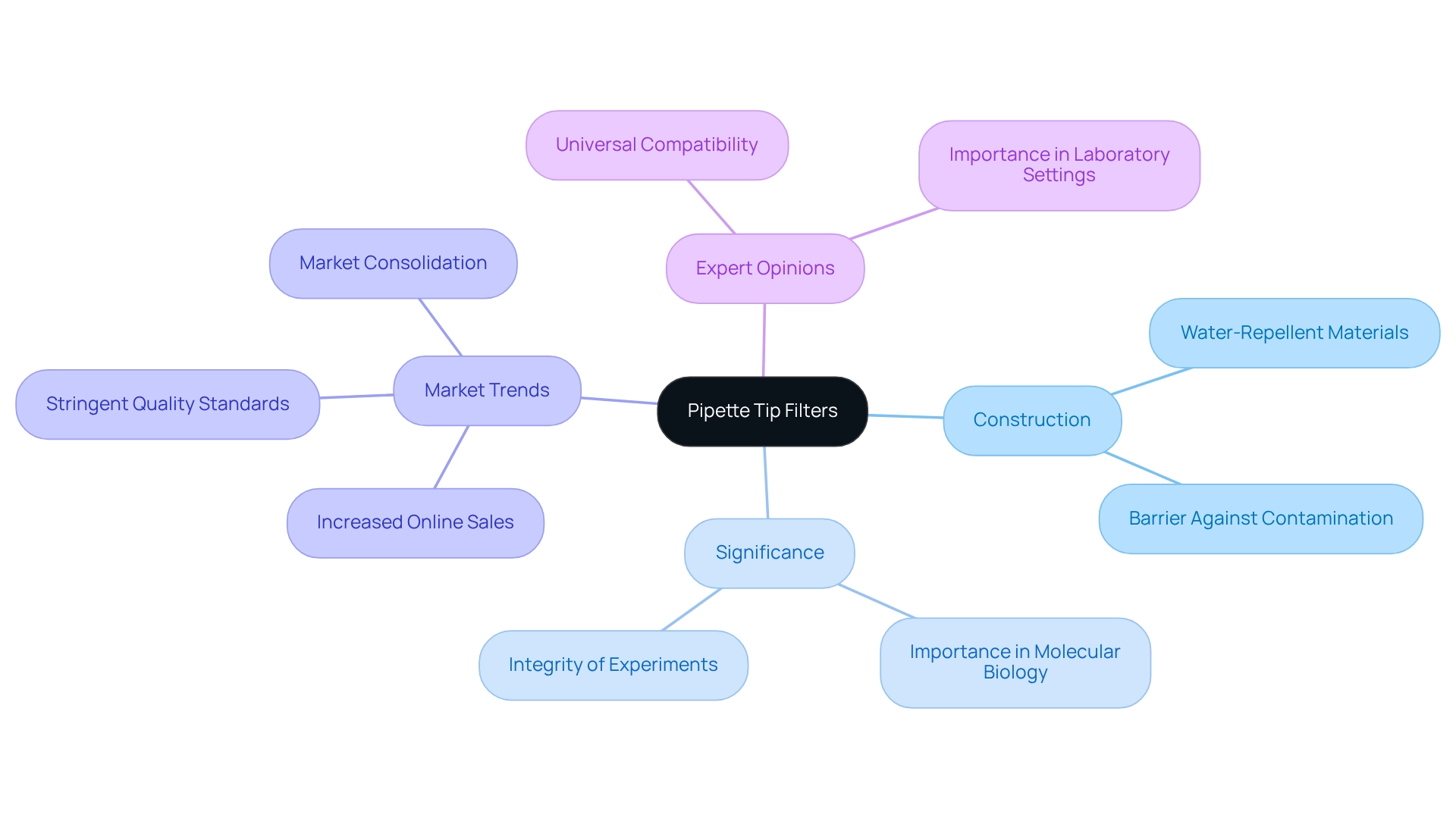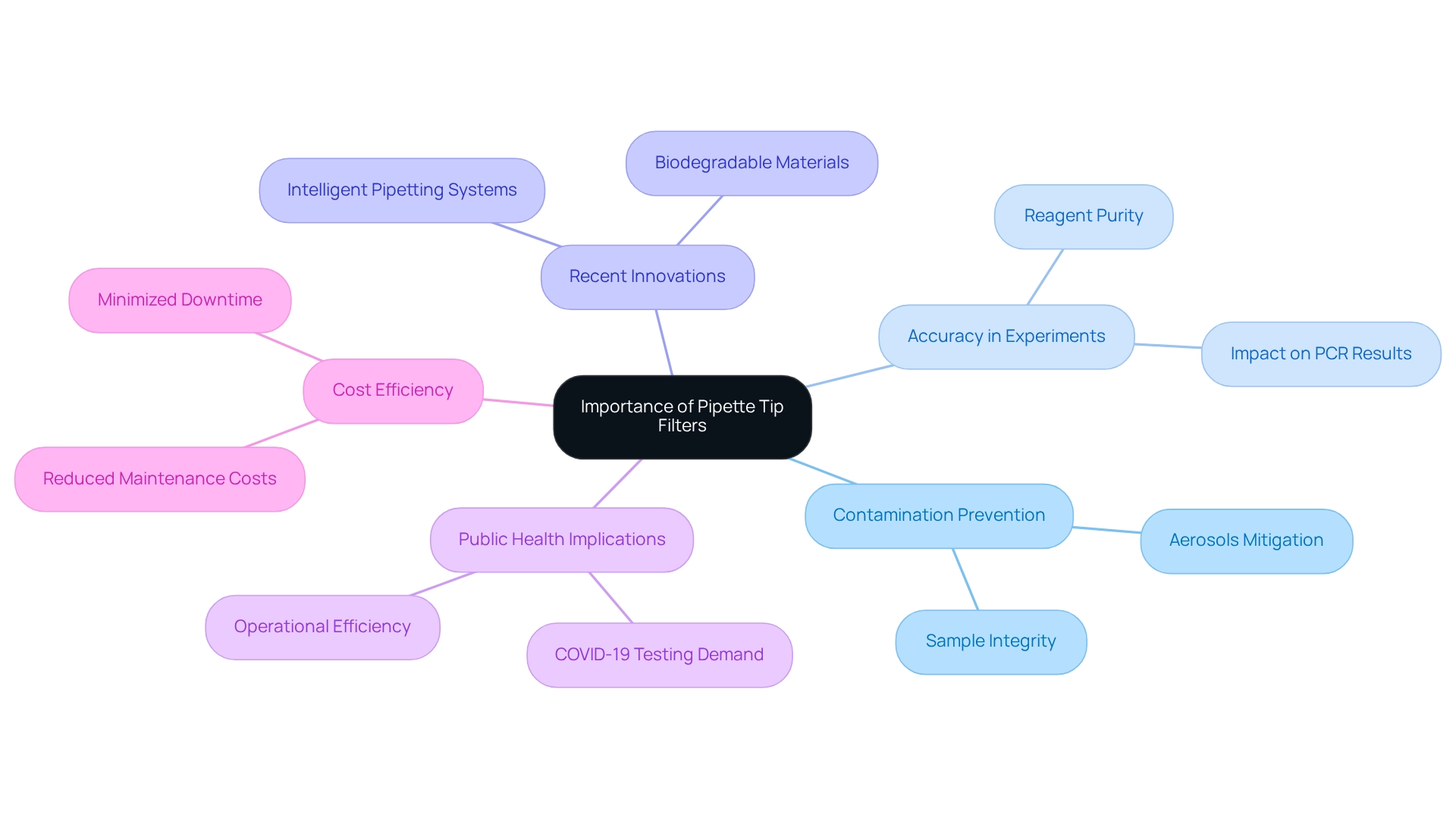Overview
Pipette tip filters serve as essential components in the realm of liquid handling, playing a pivotal role in preventing contamination. Their significance in scientific experiments cannot be overstated, particularly in molecular biology applications. These filters effectively block aerosols and liquids, thereby enhancing the reliability of experimental results and significantly reducing contamination risks. Such measures are critical for achieving precise outcomes in laboratory settings, underscoring the necessity of high-quality scientific instruments. In summary, the implementation of pipette tip filters is not merely a precaution; it is a fundamental practice that ensures the integrity and accuracy of scientific research.
Introduction
In the realm of scientific research, precision is paramount; even the smallest oversight can lead to significant consequences. Pipette tip filters have emerged as vital tools in the battle against contamination, safeguarding the integrity of samples and the accuracy of results. These specialized components serve as barriers against aerosols and liquids, playing a crucial role in enhancing the reliability of experiments, particularly in sensitive fields like molecular biology.
As the demand for high-quality laboratory practices grows, understanding the evolution, types, and importance of pipette tip filters becomes essential for professionals striving to maintain the highest standards in their work. This article delves into the pivotal role of pipette tip filters, exploring their characteristics, historical development, and the impact they have on scientific outcomes.
Define Pipette Tip Filters
These components, including pipette tip filters, are specialized elements designed for integration into liquid dispensing devices, playing a crucial role in preventing contamination during liquid manipulation. Constructed from water-repellent materials, these devices equipped with pipette tip filters act as a barrier, effectively blocking aerosols and liquids from entering the shaft. This protective feature safeguards both the device and the samples being handled, ensuring the integrity of experiments and analyses through the use of pipette tip filters.
The significance of pipette tip filters becomes particularly apparent in molecular biology applications, where even the slightest contamination can lead to substantial errors in results. Recent statistics indicate that a significant proportion of laboratories utilize nozzle end screens to mitigate contamination risks, with items like priced at $319.08, underscoring their importance in maintaining high-quality standards in scientific research.
Practical examples highlight the effectiveness of nozzle end screens across various laboratory environments, demonstrating their ability to enhance the reliability of experimental outcomes. As the tips market evolves, trends such as increased online sales and stringent quality standards are shaping the future of these vital tools, fostering innovation and growth within the sector. The case study titled 'Market Trends in Tip Accessories' illustrates how these trends are influencing the market dynamics surrounding tip screening devices.
Laboratory experts consistently stress the importance of pipette tip filters, recognizing their role in ensuring precise and repeatable results across diverse applications. As one expert noted, 'Yes, they are engineered to fit securely onto various brands and types of liquid handling devices, ensuring universal compatibility.

Contextualize the Importance of Pipette Tip Filters
Pipette tip screens are essential components in research environments where precision and accuracy are paramount. They significantly mitigate the risk of contamination from aerosols produced during pipetting, which can severely jeopardize sample integrity. The American Chemical Society emphasizes that contamination—whether introduced through reagents or environmental sources—can critically undermine the accuracy of experiments and diagnostics.
In molecular biology applications, such as PCR (Polymerase Chain Reaction), even minimal amounts of contaminating DNA can result in erroneous outcomes. By employing pipette tip filters alongside filtration systems, laboratories can achieve reliable and consistent results, thereby elevating the overall standard of scientific inquiry.
Statistics indicate that laboratories lacking these tips experience contamination levels that can drastically compromise experimental precision. Regular assessment of reagents for purity is vital to prevent such contamination, as these devices are crucial in maintaining reagent purity and ensuring the integrity of sensitive experiments. Furthermore, tip membranes extend the lifespan of dispensing devices by preventing corrosive materials from entering the apparatus, which reduces maintenance costs and minimizes downtime.
Recent advancements in the tip sector focus on enhancing accuracy, reducing contamination, and promoting sustainability. Innovations such as intelligent pipetting systems and biodegradable materials are expected to further improve efficiency in research facilities while supporting environmental sustainability. Case studies illustrate how laboratories utilizing pipette tip filters have significantly improved their precision, highlighting the filters' indispensable role in achieving high-quality results in scientific endeavors.
The heightened demand for COVID-19 testing has also underscored the critical need for substantial quantities of quality transfer tips, reinforcing their importance in public health and operational efficiency. Ultimately, the impact of pipette tip filters on PCR results and their significance in molecular biology is profound, as these filters are vital for attaining .

Trace the Origins and Development of Pipette Tip Filters
The concept of transfer device tips equipped with screens emerged as a vital response to the escalating need for contamination prevention in research environments. While the initial liquid handling devices were introduced in the early 1900s, the integration of screens into these instruments became prevalent in the 1980s. This transition was significantly driven by advancements in molecular biology techniques, which highlighted the imperative for rigorous contamination control measures.
As research facilities adopted increasingly sensitive assays, the demand for filtered tips surged, leading to their widespread incorporation into standard laboratory procedures. Today, pipette tip filters are recognized as essential components in ensuring the accuracy and reliability of scientific investigations, underscoring their critical role in refining research methodologies. The growth of the tip filter market since the 1980s has been substantial, fueled by the rising complexity of laboratory analyses and the demand for high-quality results.
In 2021, the U.S. accounted for approximately 85.0% of the market for laboratory droppers, underscoring its significance within the sector. Key players such as Thermo-Fisher Scientific, Sartorius AG, and Eppendorf AG are pivotal in driving innovation and meeting the increasing demand for tips. As highlighted by Debashree Bora, the rise in consumption of processed and packaged food in industrialized nations, coupled with evolving consumption patterns in developing economies toward convenience foods, are factors that favor the industry's expansion.
Collectively, these elements illustrate the evolution of pipette technology and the indispensable role of in modern research settings.
Identify Key Characteristics and Types of Pipette Tip Filters
Pipette tip sieves are crucial elements in research environments, available in various types tailored for specific applications. These devices are characterized by their material composition, typically polyethylene or other hydrophobic substances, and pore size, which significantly influences their efficiency in capturing aerosols and contaminants. The primary categories of include:
- Standard Filter Tips: Offering basic protection against aerosols, these tips are suitable for general laboratory use. They are frequently utilized for loading agarose gels and isolating plasmid DNA, underscoring their versatility across multiple applications.
- Low Retention Filter Devices: Engineered to minimize liquid retention, these devices excel in managing viscous solutions, ensuring optimal sample recovery.
- Specialized Filter Attachments: Designed for specific tasks, such as handling volatile or corrosive substances, these attachments enhance protection and reliability.
Selecting is vital for preserving sample integrity and ensuring precise outcomes in experimental procedures. A recent case analysis highlighted the differences between filtered and standard applicators, concluding that pipette tip filters are indispensable for sensitive applications to prevent contamination, while standard tips are more economical for routine tasks. This underscores the importance of choosing the right type based on the specific needs of the laboratory, thereby ensuring optimal performance and reliability in scientific endeavors.
As Lab Pro asserts, "No matter which tip you go with just make sure that it is of high quality so that it maintains its form, performance, and seal." Furthermore, pipette tips are designed to fit securely onto various brands and types of pipettes, ensuring universal compatibility and enhancing convenience in laboratory settings.
Conclusion
Pipette tip filters are indispensable tools in the pursuit of accuracy and reliability in scientific research. They serve as critical barriers against contamination, particularly in sensitive applications like molecular biology, where even minute impurities can lead to erroneous results. The evolution of pipette tip filters since their introduction in the 1980s highlights their growing importance in laboratory protocols, driven by the increasing complexity of scientific analyses and the need for high-quality outcomes.
The diverse range of pipette tip filters—standard, low retention, and specialized types—cater to various laboratory needs, ensuring that researchers can select the most appropriate option for their specific applications. This versatility enhances sample integrity and minimizes the risk of contamination, ultimately contributing to the reliability of experimental results. As laboratories continue to prioritize precision, the demand for high-quality pipette tip filters is expected to rise, further emphasizing their role in maintaining stringent quality standards.
In conclusion, the significance of pipette tip filters cannot be overstated. They are not just accessories but essential components that uphold the integrity of scientific work. As the landscape of laboratory practices evolves, understanding and utilizing these filters will be crucial for researchers aiming to achieve accurate, reproducible results, thereby advancing the frontiers of scientific knowledge.




